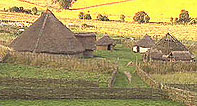Pytheas winters in the islands of Britain. From north to south, and probably from east to west, he travels through the islands and provides the dimensions of the main island. He also gives a complete description of the way of life of the Britons. He also does not forget to take measurements of latitude.
Pytheas made a complete tour of the British Isles (Great Britain). He probably also wintered there, which gave him the opportunity to deepen his knowledge of the islands and the natives.
According to Pliny, "Albion is its name, when all call it Britannia." According to Diodorus, who may have given the most accurate information, "Britannia is triangular in shape, larger than Sicily. The island extends obliquely along the coast of Europe and the point nearest to the continent is the cape which men call Kantion, is about 100 stades from the continent, at the place where the sea has its outlet, while the second cape known as Belerion is four days' journey from the continent, and the last, as writers tell us, is far out in the ocean, and it is called Orkas. On the British side, the shortest, that against Europe is 7500 stades, the second, from the strait to the point is 15000 stades, and the last is 20000 stades".
 |
Dwellings in Britain |
The general description is correct, but the dimensions are overestimated. Pytheas probably misunderstood, while sailing along the coast, the real dimensions of the island called Albion, but people call it Britannia among themselves. They are Britons or Pritons (1), which means tin. It may also be the name given to them by the Celts of Armorica and Pytheas simply takes it up. From the west, Pytheas goes back quickly. He goes ever further. He arrives at the island of Lewis. There, he takes advantage of the stopover to make a second measurement with his gnomon. Hipparchus gives the latitude of 58°14’. The sailors that Pytheas meets tell him that there is a distant land. So, he wants to go even further north, but his pilots advise him against it. Bad weather is about to set in and as the days are even shorter he has no choice: he decides to spend the winter in Britannia. He will wait until next summer.
During this long winter, what does Pytheas do? He turns into an ethnologist. Strabo says of him "on this British land, wherever it was accessible, he claims to have descended". He also visits Ireland (see next page). About the British, Strabo says: "of fruits and animals there is a complete lack of some and a shortage of others and the people live on millet and other herbs, fruits and roots; and where there is grain and honey the people also make a drink of it. As for the grain, since they have no pure sun, they thresh it in large shelters having previously harvested the ears of corn". Diodorus gives us other details: "Brittany, it is said, is inhabited by indigenous tribes who have preserved their way of life from ancient customs. For example, they use chariots for war… Their houses are simple and made mostly of reeds and wood. Of their grain, they cut only the heads, and store them in covered shelters, and every day they choose the ripe ears and grind them, and in this way they obtain their food. Their behavior is simple and very different from the aggressiveness and wickedness that characterizes the people of today. Their way of life is simple, very different from the soft life that comes from luxury. The island is densely populated, and the air is cold, as is normal for a country that is located under the Bear. They have many kings and chiefs who generally live in peace with each other.”
Pytheas makes another measurement with his gnomon. Hipparchus gives us 54°14’. Where did he take his measurement? It corresponds to the north-east of Ireland, the Isle of Man, or perhaps the bottom of Morecambe Bay where he may have stayed for a few months. And why not Norway?
Finally, spring is here again, and he goes back north, passes the Hebrides again, then the extreme north of the British Isles whose cape is called Orkas. He then makes a stopover in the Shetland Islands. He takes a new measurement of the length of the shadow, which transformed into a fraction of a circumference, then into modern notation by Hipparchus gives 61°.
But where is this mysterious place that the natives call Thule?
Sailors regularly make the trip, so why not him?
(1) Pritons: painted men?

